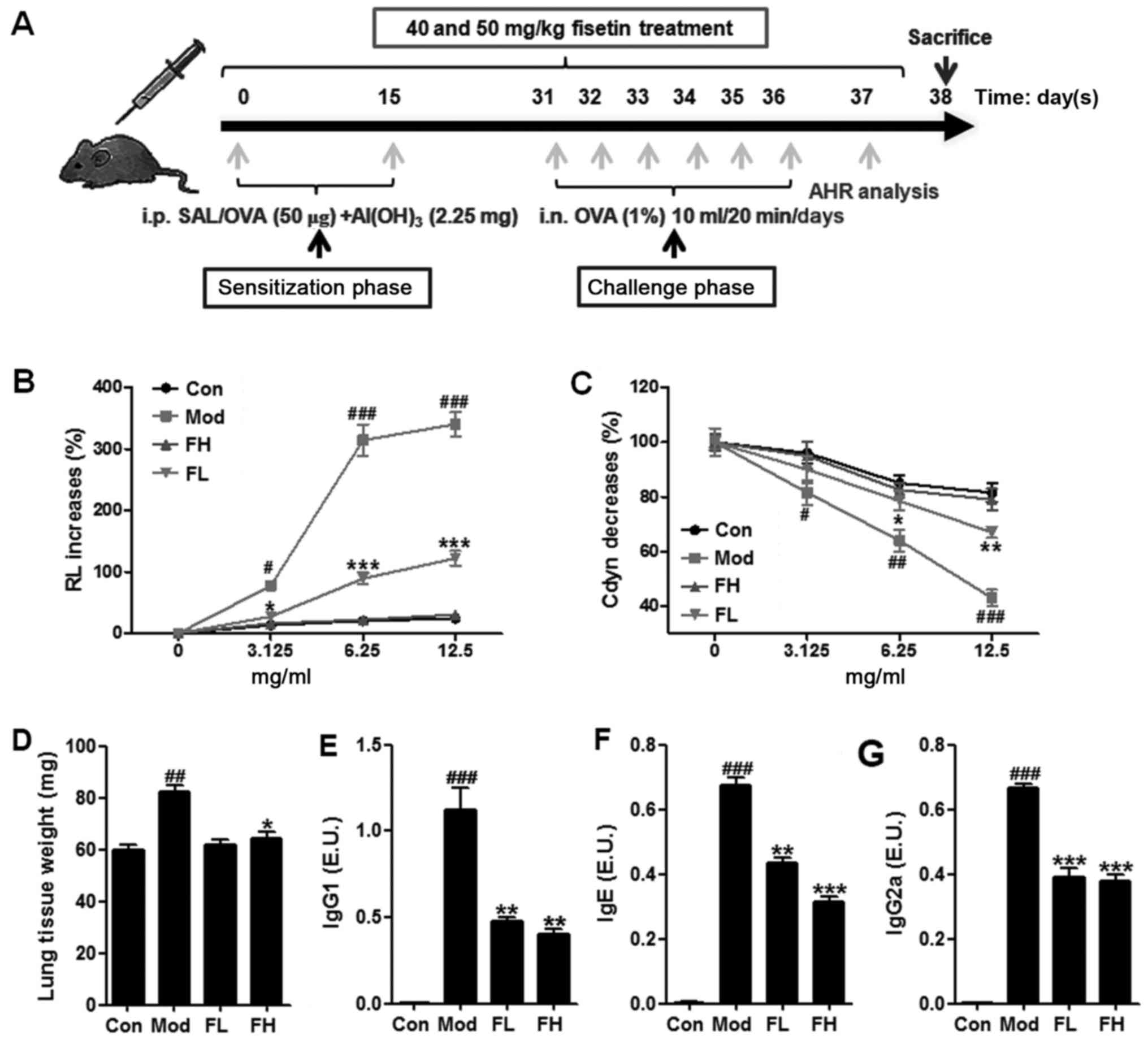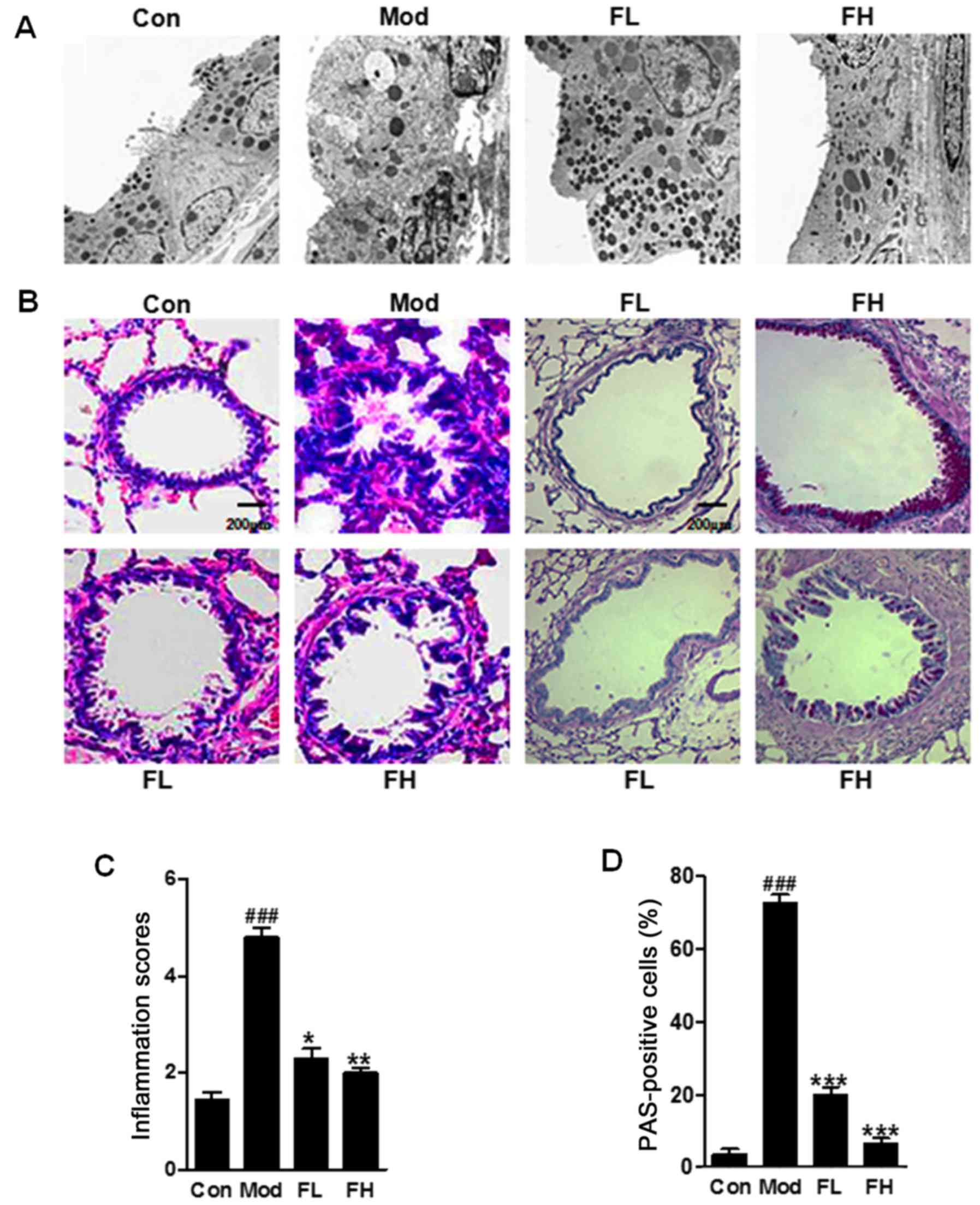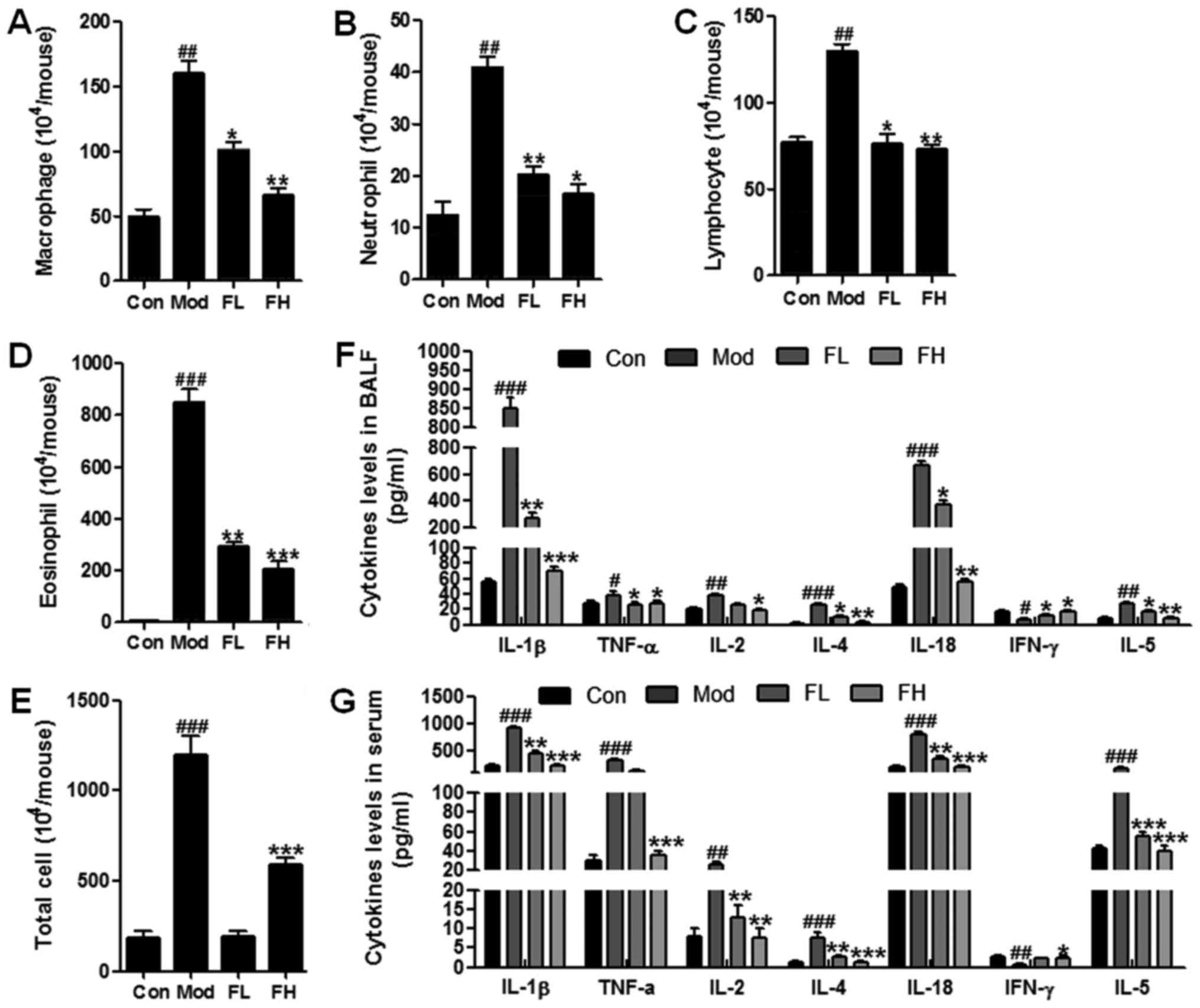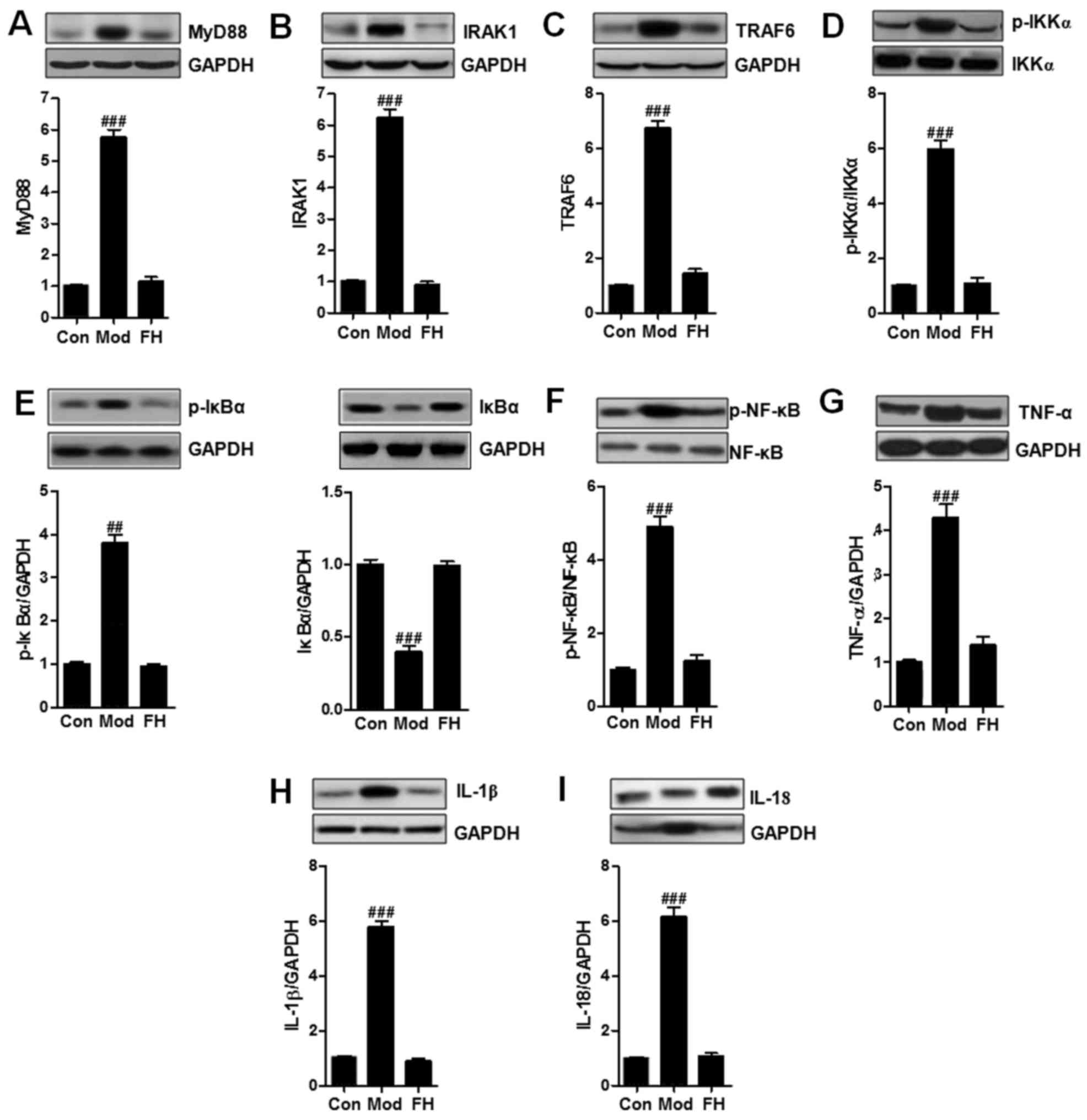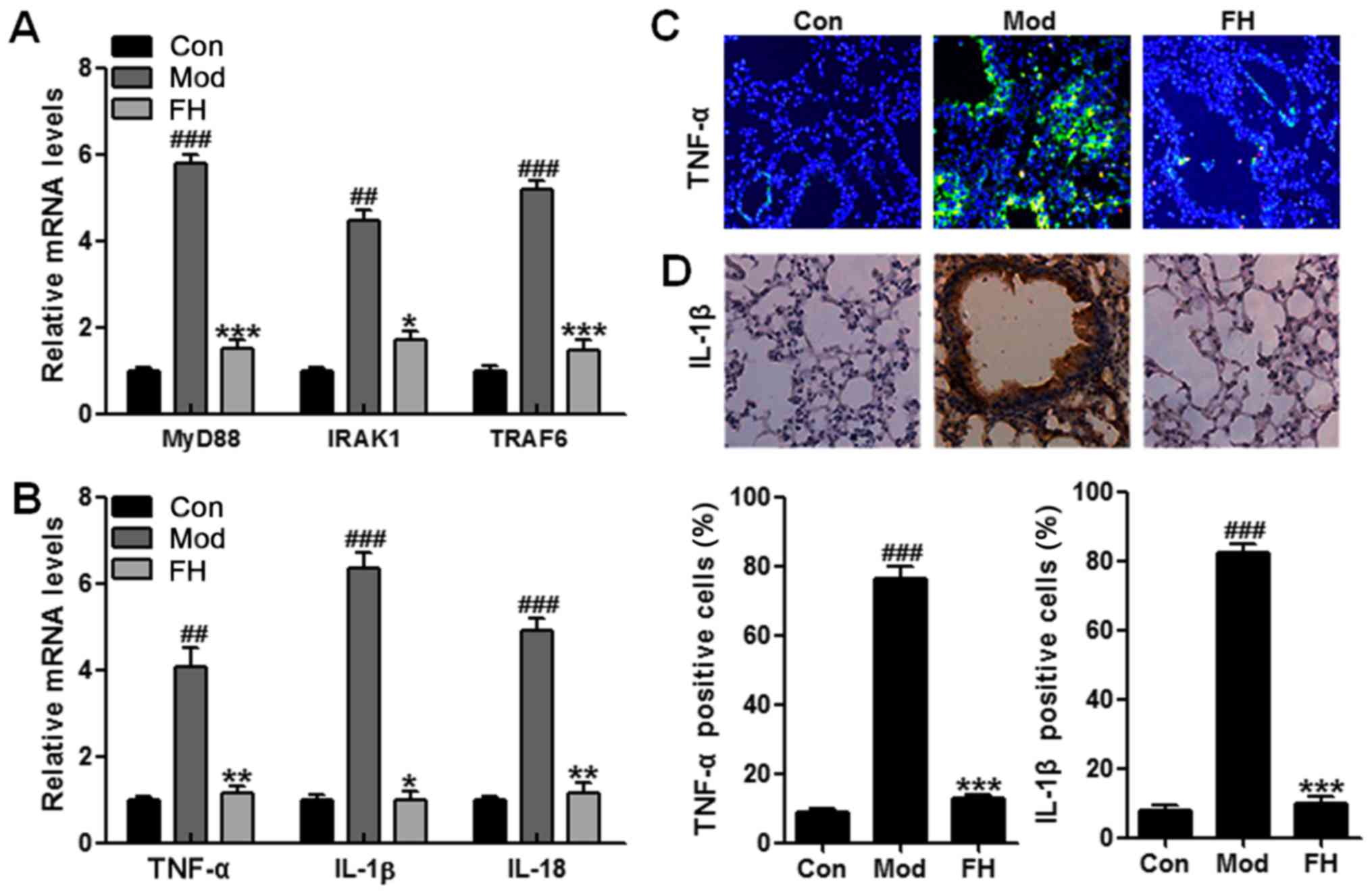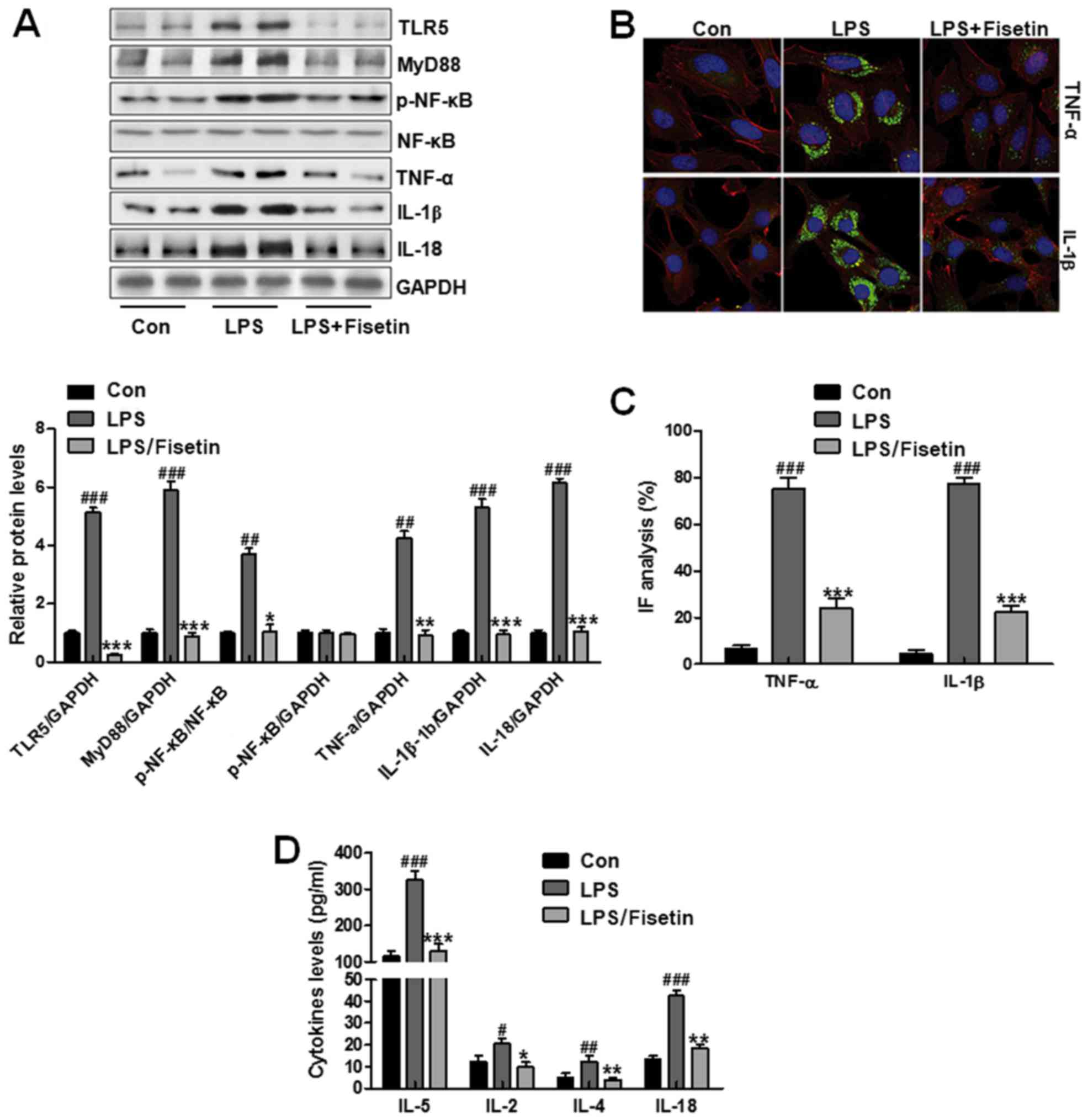Fisetin-treatment alleviates airway inflammation through inhbition of MyD88/NF-κB signaling pathway
- Authors:
- Published online on: March 22, 2018 https://doi.org/10.3892/ijmm.2018.3582
- Pages: 208-218
-
Copyright: © Huang et al. This is an open access article distributed under the terms of Creative Commons Attribution License.
Abstract
Introduction
Asthma, as a chronic inflammatory airway disease, is a significant global disease which is a common source of morbidity and a significant cause of preventable mortality (1,2). Generally, it is caused due to the inhalation of allergens, house dust, pollens, air pollutants, and inhalants, which are characterized by airway hyper-responsiveness, eosinophilic airway inflammation, as well as mucus hypersecretion. Inflammatory cells secrete chemical regulators related to asthma development closely (3,4). Asthma could result in incompletely-reversible airway obstruction, especially at late stages (5). Thus searching for effective therapy that targets airway inflammation is required.
In the last few decades, exploring the efficacy of natural compounds against various human metabolic diseases have received increased attention among the scientific community (6). Compounds from plants belonging to different groups, including flavonoids, alkaloids and polyphenols evaluated for their cancer preventive effects have yielded promising data, thus offering a potential therapeutic strategy against deadly diseases (7). The flavonol fisetin (3,3′,4′,7-tetrahydroxyflavone), involved in fruits and vegetables such as apples, strawberries, grapes, persimmon, cucumber, and onion, was suggested to possess anti-inflammatory, anti-oxidant, anti-microbial, and significantly anti-carcinogenic activity when studied in various animal model systems and cell culture (8). Fisetin was able to ameliorate inflammation response and oxidative stress in diseases, such as bowel disease, oxidative skin damage, as well as lung injury through inflammation suppression, and oxidative inhibition (9). In addition, fisetin possesses significant therapeutic effects against diabetic complications and atherosclerosis (10). However, the role of fisetin in regulating airway inflammation is not understood clearly and requires more studies.
Nuclear factor-κB (NF-κB) signaling activity in asthma is proved by upregulated NF-κB nuclear localization, IκB phosphorylation, as well as IκB kinase-β (IKK-β) expression in the airway tissue of asthmatics (11). Increased evidence has suggested that NF-κB nuclear binding or staining is also observed in the inflammatory cells of induced asthmatic sputum (12,13). Further, NF-κB phosphorylation in the airways of allergen-challenged mice is ameliorated for Toll-like receptor 2 (TLR2) or TLR4 gene deletion, indicating that the innate immune system attributes to NF-κB activity in asthma (14,15). However, up until now, the effect of TLR5 on the progression of asthma is not clearly illustrated.
Therefore, the present study, to our knowledge, is the first time that fisetin was investigated for its the effects on ovalbumin (OVA)-induced mice with asthma. Our results suggested that fisetin was at least partly involced in improving progression of airway inflammation via activation of MyD88 and NF-κB signaling pathways. Fisetin is able to inhibit OVA-induced asthma by inactivating MyD88 and NF-κB signaling pathway-regulated inflammatory responses.
Materials and methods
Reagents and animal models
Forty male C57BL/6 mice weighing 20–25 g were obtained from Nanjing Medical university (Nanjing, China). The mice were maintained in a room temperature at 25±2°C and relative 50±5% humidity-controlled environment with a standard cycle of 12 h light/dark. The model animals were administered standard diet and water ad libitum provided in the cages. The experimental procedures of this study were approved by the ethics Committee on Animal Research at Qinhuangdao First Hospital (Hebei, China). The mice in the experiments were divided into 4 groups randomly as follows: i) the control group (Con); ii) the OVA (Sigma-Aldrich, St. Louis, MO, USA)-induced group (Mod); iii) 40 mg/kg fisetin-treated OVA-induced group (FL); and iv) 50 mg/kg fisetin-treated OVA-induced group (FH). OVA was purchased from Sigma-Aldrich.
Asthmatic model establishment
The mice were arbitrarily divided into four groups (n=10 each group) as described above. As shown in Fig. 1A, mice were sensitized with an intraperitoneal injection of 0.2 ml saline containing 50 μg OVA and 2.25 mg aluminum hydroxide. From day 31, the mice in Mod, FL and FH groups were challenged for 6 consecutive days with a 1% (w/v) OVA solution, which was administered with an ultrasonic nebulizer (Yuyue, Jiangsu, China). The mice in the Con group were sensitized and challenged with 0.09% saline (without 2.25 mg aluminum hydroxide). At the same time, the OVA-induced mice were treated with fisetin at different concentrations. Following the animal model establishment, the blood samples were collected from the mice immediately after the airway hyperresponsiveness (AHR) measurements and stored at 4°C for 2 h before being centrifuged at 5,000 × g for 15 min at 4°C. The resulting serum was collected, repackaged and stored at −80°C for the following studies. The whole lung tissues were harvested on 4°C glacial table and weighed, and either frozen in liquid nitrogen and kept at −80°C for analysis.
Airway resistance and function
The airway resistance of treated animals was determined as an increase in pulmonary resistance after the challenges with 0, 3.125, 6.25 and 12.5 mg/ml aerosolized β-methacholine (MCh) (Sigma, Shanghai, China). The resistance of the 0.45 cm H2O.s.ml−1 orotracheal tube was subtracted from all airway resistance measurements. Data are presented as the pulmonary resistance (RL) and the lung dynamic compliance (Cdyn) of the three independent experiments.
Bronchoalveolar lavage fluid (BALF) collection
BALF collection was performed via lavaging the left lung with 0.3 ml aliquots of phosphate-buffered saline (PBS) (twice) through the tracheal cannula with total volume of 0.6 ml. The resulting mixture was centrifuged at 1,000 × g for 10 min at 4°C. The supernatant was then collected and stored at −80°C for further analysis. The pellet from the BALF was resuspended in 0.1 ml PBS for the cell count and classification analysis with an automatic hematology analyzer (Mindray, Shenzhen, China).
Inflammatory cell counts in BALF
BALF was isolated as described above for analysis. The animal models were sacrificed after the final challenge through an intraperitoneal injection of 50 mg/kg pentobarbital (Hanlim Pharm. Co., Seoul, Korea), then a tracheostomy was conducted. The total number of inflammatory cells was calculated by counting the cells in at least five fields of a hemocytometer after exclusion of the dead cells through Trypan blue staining. The counts of differential cells in BALF were calculated by Diff-Quik® staining reagent (IMEB Inc., San Marcos, CA, USA) according to the manufacturer's protocols. The number of neutrophils, lymphocytes, and macrophages was evaluated through multiplying the percentages from the total yield. Images of each slide were photographed with a digital camera mounted on a microscope (Nikon, Tokyo, Japan).
Enzyme-linked immunosorbent assay (ELISA)
Inflammatory mediators of cytokines in BALF and serum, such as interleukin-1β (IL-1β), tumor necrosis factor-α (TNF-α), IL-2, IL-4, IL-18, interferon-γ (IFN-γ) and IL-5, were determined by ELISA kits according to the manufacturer's protocols. ELISA (both from R&D Systems Inc., Minneapolis, MN, USA) was also applied to determine the expression levels of OVA-specific IgE, IgG2a and IgG1 in serum.
Determination of CD80 and CD86 on DCs
The lungs were isolated from treated mice and digested as previously described (16). Tissues were dissociated and single cell suspensions were obtained. The following antibodies were purchased from eBioscience (San Diego, CA, USA): 1:800 anti-CD80 Pe, 1:600 anti-CD86 PE, and isotype control antibodies. Lung DCs were labeled with antibodies. After 30 min at 4°C, cells were washed twice and fixed in 2% paraformaldehyde (PFA; Alfa Aesar, Haverhill, MA, USA) diluted in PBS-BSA 0.2% for 15 min at 4°C. Cells were washed, resuspended in PBS-BSA 0.2%, and analyzed by flow cytometry. Finally, samples were collected and analyzed on a FACSCalibur flow cytometer (BD Immunocytometry Systems, Franklin Lakes, NJ, USA).
Immunochemical analysis
The lung tissue samples were collected, and fixed in 4% paraformaldehyde. Then, they were embedded in paraffin and cut into 4 μm sections for histopathological analysis. Lung sections were then stained with hematoxylin and eosin (H&e) and periodic acid-Schiff (PAS) (IMEB Inc.) to calculate the inflammatory changes. In eight animals from each group, five arbitrarily selected fields of each mouse was photographed with an optical microscope (Nikon) and the images were determined and analyzed in detail. The airway inflammation degree in each group was evaluated by three independent analysts. Histopathological evaluation was based on the intensity of the inflammatory infiltrate in randomly selected areas around the tissues and was scored as 1 (no inflammatory cells), 2 (few cells), 3 (a few cells), 4 (moderate cell infiltration), 5 (large number of inflammatory cells) and 6 (completely inflammatory cells), assuming a linear relationship between the amount of inflammation and inflammatory score.
As for immunohistochemistry, IL-1β antigen was calculated with a specific rabbit antibody (Cell Signaling Technology, Danvers, MA, USA). The antigen-antibody complexes were then visualized through the avidin-biotin-peroxidase complex kit (elite kit; Vector Laboratories, Burlingame, CA, USA). The sections were finally counterstained with hematoxylin and also mounted. Images of sections were photographed with a digital camera (Nikon).
Immunofluorescent analysis
Lung tissue samples were perfused with PBS, fixed with 4% paraformaldehyde and then embedded. The 8 μm thickness frozen sections were prepared for analysis and staining. The slides were washed with PBS following methanol fixation for 10 min at −20°C and rinsed with PBS. Slides were then incubated in blocking solution for 2 h and permeabilized by 0.3% Triton X-100 in PBS for 30 min at room temperature. During incubation with polyclonal rabbit anti-mouse TNF-α and IL-1β (Cell Signaling Technology) in a humid chamber overnight at 4°C, the antigen detection was carried out with Alexa 488 goat anti-rabbit IgG (Invitrogen, Carlsbad, CA, USA) for 2 h. Negative control sections were processed by omitting the specific primary antibody. The sections were added with mounting media with 4′,6-diamidino-2-phenylindole (DAPI; Roche, Basel, Switzerland). The Immunofluorescent labelings were analyzed by fluorescence microscope (Zeiss Axio Imager).
Transmission electron microscope observation
Lung tissues were cut into small pieces, fixed in 2.5% glutaraldehyde and osmium tetroxide. Tissues were rinsed with PBS, and embedded after dehydration of ethonal and acetone. Samples were then cut into thin slices with uranium acetate-lead citrate double staining for observation.
Cell culture and treatment
The cells of TC-1 (ATCCCRL-2493) were obtained from American Type Culture Collection (ATCC, Rockville, MD, USA). They were cultured at the permissive temperature (37°C) in DMEM medium containing 15% fetal bovine serum (FBS) and supplemented with 1% penicillin-streptomycin-neomycin both provided by Gibco-BRL Life Technologies (Grand Island, NY, USA) with a humidified incubator in 5% CO2 atmosphere. The cells could be used and treated with 100 ng/ml lipopolysaccharide (LPS) for 24 h combined with or without TLR5 siRNA (sc-40263; Santa Cruz Biotechnology, Inc., Santa Cruz, CA, USA) according to the manufacturer's instruction. Then, cells were carefully harvested for further analysis.
Western blot analysis and reverse transcription-quantitative PCR (RT-qPCR)
Proteins were extracted from the lung tissue or cells using T-PER Tissue Protein extraction reagent kit (Thermo Fisher Scientific, Waltham, MA, USA) according to the manufacturer's instructions. Primary antibodies of TLR5, IKKα, p-IKKα, IκBα, p-IκBα, NF-κB, p-NF-κB, IL-1β, TNF-α, IL-18 and glyceraldehyde 3-phosphate dehydrogenase (GAPDH; Cell Signaling Technology) were used in the study. The immunoactive proteins were detected by using an enhanced chemiluminescence western blot detection kit. The bands were observed using an ECL western blot analysis system (GE Healthcare, Pittsburgh, PA, USA) and exposed to Kodak X-ray film.
Analysis of qPCR was performed as previously described (17). Fold induction values were calculated using the to 2−ΔΔCq method, where ΔCq represents the differences in cycle threshold number between the target gene and GAPDH. ΔΔCq represents the relative change in the differences between the control and treatment groups. The primers used in the study are shown in Table I.
Statistical analysis
All data were calculated as means ± standard error of the mean (±SD) and analyzed by SPSS software (version 17.0; SPSS, Inc, Chicago, IL, USA). Groups were compared with Student's t-test or one-way analysis of variance (ANOVA), followed by Newman-Keuls post-hoc analysis. A p-value of <0.05 was considered statistically significant.
Results
Fisetin decreased AHR in the OVA-induced asthmatic mice
Following the sensitization and challenge protocol (Fig. 1A), a well-established animal model of OVA-induced asthma was used to calculate the effect of fisetin on asthmatic mice. The results of this study showed that short-term OVA challenge of mice with Mch resulted in a significant increase in AHR mice of RL compared to mice in the control group (Fig. 1B). Fisetin-treated mice at different concentrations led to a significant decrease in the AHR mice of RL towards Mch in comparison with the OVA-induced asthmatic mice. In addition, in a Mch dose-dependent manner, Fisetin administration showed significant inhibitory activity in the AHR mice. Furthermore, short-term OVA challenge in the mice also resulted in a significant downregulation of Cdyn towards progressive doses of Mch compared to the mice in the control group (Fig. 1C). Fisetin treatment resulted in upregulated Cdyn in comparison to the OVA-induced asthmatic mice. The data above suggested that fisetin had a potential role in the regulation of AHR progression.
The lung weight of mice in the different groups was measured (Fig. 1D). Higher weight of mice was observed in mice with OVA induction than that in the control group. However, mice with fisetin administration displayed decreased weight of lungs, suggesting that fisetin may be effective in AHR development in mice. After OVA treatment, the levels of OVA-specific IgG1 (Fig. 1E), IgE (Fig. 1F), IgG2a (Fig. 1G) in the Con group were too low to be evaluated. OVA-treatment led to significant upregulation of IgG1, Ige and IgG2a in BALF samples. Of note, fisetin administration reversed the increased IgG1, IgE and IgG2a significantly.
Fisetin attenuates airway inflammation in the lung tissue samples from OVA-sensitized/challenged animal model
The cell structure was injured seriously in the OVA-induced lung tissue of mice (Fig. 2A). In the fisetin-induced group the cell structure was as integrated as the control ones. The OVA-challenged mice displayed marked infiltration of inflammatory cells into the peribronchial and perivascular lesions in the lung tissue (Fig. 2B and C). However, in the fisetin-treated mice, the cell infiltration was downregulated significantly in the OVA-challenged animal model. In addition, the lung sections with PAS staining showed that mucus was over-produced in the bronchial airways in the OVA-induced mice. Notably, the mucus production was reduced in the lung tissue samples of mice with fisetin administration than that in the OVA-challenged mice (Fig. 2B and D). Further, morphological alterations of cells in lung tissue samples were observed. The data above suggested that fisetin ameliorated airway inflammation induced by OVA-sensitization and challenge in mice.
Fisetin decreases inflammatory cell counts and pro-inflammatory cytokine release
Inflammatory response is a major cause contributing to OVA-sensitization and challenge-induced airway inflammation (18). Thus, in this regard we were attempted to explore whether fisetin could attenuate inflammation response in OVA-induced asthmatic mice. The number of inflammatory cells, such as macrophages, neutrophils, lymphocytes and eosinophils, was upregulated significantly in the BALF of OVA-sensitized/challenged mice in comparison to the wild-type controls (Fig. 3A–D). However, especially eosinophils, and the number of other cells, in the BALF of OVA-induced mice was downregulated markedly in the fisetin-treated mice compared to the OVA-sensitized/challenged mice. Also, the total cells were calculated (Fig. 3E). Similarly, the total inflammatory cells were accelerated in the mice with OVA-treatment, which was decreased remarkably in OVA-induced asthmatic mice with fisetin administration. Moreover, pro-inflammatory cytokines, including IL-1β, TNF-α, IL-2, IL-4, IL-18, IFN-γ and IL-5, in BALF and serum were calculated respectively (Fig. 3F and G). We found that cytokines of IL-1β, TNF-α, IL-2, IL-4, IL-18 and IL-5 were stimulated highly in the Mod group compared to the Con group. Fisetin reduced the over-expression of these cytokines induced by OVA in mice. In contrast, IFN-γ was downregulated in the OVA-induced wild-type mice. Interestingly, it was upregulated due to fisetin treatment in OVA-induced mice (Fig. 3F and G). Also, these cytokines represent similar results in the serum of mice. Taken together, the results further indicated that fisetin may be useful in airway inflammation via inflammation suppression.
In addition, CD80 and CD86 are known to be associated with AHR progression. Following the procedure of the animal model, airway DCs isolated from lungs were analyzed for the expression of costimulatory molecules, including CD80, and CD86 by flow cytometry. In this study, we found that CD80 and CD86 positive cells were higher in the OVA mice compared with the Control ones via flow cytometry assays (Fig. 4A and B), but fisetin reduced CD80 and CD86 positive cells in the lung tissue samples of OVA-induced asthmatic mice. The data in this regard further indicated that fisetin was, at least partly, effective on the OVA-induced asthmatic mice.
TLR5-deficiency attenuates inflammation response in OVA-induced asthmatic mice via MyD88 and NF-κB (p65) signaling pathway suppression
TLR5-modulated airway inflammation was supposed to be linked with inflammation response. Thus, in this regard, the possible mechanism by which TLR5 performed its role in asthmatic mice was explored. TLR5-regulated signaling pathway through MyD88 activation is known to be related to NF-κB signaling pathway. NF-κB activation is a key leading to pro-inflammatory cytokines secretion and inflammatory response progression (19). Western blot analysis was used to reveal the alterations of MyD88 (Fig. 5A), IRAK1 (Fig. 5B), TRAF6 (Fig. 5C), p-IKKα (Fig. 5D), p-IκBα (Fig. 5E), p-NF-κB (Fig. 5F), TNF-α (Fig. 5G), IL-1β (Fig. 5H), and IL-18 (Fig. 5I). MyD88 was upregulated in the OVA group compared to that in the Con group. We considered that fisetin downregulated MyD88 expression. Subsequently, the downstream signals of IRAK1 and TRAF6 were also reduced significantly in OVA-treated mice. Then, the phosphorylated IKKα, IκBα, and NF-κB induced by OVA in OVA-induced mice was inactivated due to fisetin administration. Finally, the releasing of typical pro-inflammatory cytokines, such as TNF-α (Fig. 5G), IL-1β (Fig. 5H), and IL-18 (Fig. 5I), were reduced significantly in the fisetin-treated mice.
For further confirmation, RT-QPCR was applied to analyze the gene mRNA levels. MyD88 signaling pathway was inactivated for fisetin treatment in OVA-induced mice (Fig. 6A). Also, TNF-α, IL-1β and IL-18 mRNA levels were suppressed in the OVA-induced mice after fisetin administration (Fig. 7B). Moreover, immunofluorescence and immunochemical analysis further proved that TNF-α and IL-1β were stimulated in OVA-induced mice, which were downregulated significantly in OVA-treated mice with fisetin, which was consistent with previous results (Fig. 6C and D). In conclusion, the data suggested that fisetin could regulate AHR in the OVA-induced asthmatic mice via MyD88- and NF-κB-dependent signaling pathway.
Fisetin ameliorated inflammtory response in LPS-induced cells in vitro
Cell experiments were necessary to confirm the role of fisetin in airway inflammation progression. TC1 cells were used here, which were treated with LPS to produce inflammation response. Then, 10 μM fisetin was performed to downregulate TLR5 expression and explore how inflammation response changed in vitro. First, western blot analysis was used to assess TLR5 levels, which was expressed highly in LPS-induced groups. Of note, in fisetin-treated groups, TLR5 expression levels were downregulated significantly. Then, the down-streaming signal MyD88 was also reduced, causing inactivation of NF-κB and downregulation of IL-18, TNF-α and IL-1β (Fig. 7A). In Fig. 7B and C, immunofluorescent assays indicated that pro-inflammatory cytokines of TNF-α and IL-1β were reduced in fisetin-treated groups compared to that in the LPS-treated groups. Finally, other pro-inflammatory cytokines, IL-5, IL-2, IL-4 and IL-8, in PBS-treated group were higher compared to the control group, which was decreased in fisetin-treated group (Fig. 7D). The data further confirmed that fisetin was involved in airway inflammation, and its downregulation had an inhibitory role in pro-inflammatory cytokine secretion.
Discussion
The present study investigated the possible effect of fisetin on allergic asthma and revealed the underlying mechanism by which fisetin performed its role in ameliorating OVA-induced mice. Allergic asthma is an inflammatory condition of the airway which is caused by exacerbated responses to inhaled allergens and characterized by reversible airway obstruction, infiltration of eosinophils, and increased mucus production (5,20). Some characteristic features of acute asthma are found in the OVA-induced animal asthma model, which includes an accelerated airway responding to Mch as well as eosinophil-rich airway inflammation (21). Airway neutrophils are clinically important due to their increasing relation to asthma severity. Besides, sputum neutrophils have negative relationship with airflow obstruction and lung function in asthma (22). Hence, stimulation that upregulates airway neutrophilia may lead to asthma pathophysiology. In the present study, we found that OVA-treatment induced high level of neutrophils, as well as other important inflammatory cells, including macrophages, lymphocytes and eosinophils. Fisetin reversed these cell counts. In addition, short-term OVA inhalation led to a marked upregulation in RL, and a pronounced downregulation in Cdyn towards the increased Mch doses. Also, H&E and PAS staining of the lung slices suggested a significant increase of inflammatory response in OVA-induced tissue samples. The results above suggested fisetin may be considered as an essential compound for prevention of airway inflammation.
Cytokine functions are characteristic features of allergic asthma, which have been considered in AHR and eosinophilic inflammation (14,23). IL-1β, IL-18 and TNF-α are very well known as essential indicators of inflammation response (24–26). IL-4 is important for the development of AHR in animal models (27,28). IL-5 is involved in eosinophil maturation, differentiation, recruitment, as well as survival (29). Fisetin was originally identified in a screen for flavonoids that could prevent oxidative stress-induced nerve cell death (30). Fisetin is an agent that is clinically effective with a broad range of anti-oxidative, anti-inflammatory and anti-tumor activities against solid tumors, such as breast, prostate, as well as colorectal tumors (31,32). Fisetin also has anti-inflammatory activity both in vitro and in vivo that fisetin reduced the level of inflammatory cytokines TNFα, IL-1β and IL-6 in UVB-exposed skin (33). Fisetin has been suggested to perform its role in suppressing tumor growth by regulating DNA and apoptosis (34). Further, there are lower levels of IFN-γ in asthma generally (35,36). IFN-γ is known to suppress antigen-induced AHR in animals, suggesting that enhanced levels of IFN-γ may be involved in the responses to AHR (37). This study also indicated similar result that IFN-γ enhancement was related to fisetin-regulated airway inflammation in OVA-induced mice.
The activation of NF-κB occurs when it dissociates from IκBα, as the negative regulator for NF-κB, which is degraded in the process. NF-κB phosphorylation involves IκBα activation, which is catalyzed by IKK (38). Liberation from IκB promotes NF-κB to translocate into the nucleus. Then, it induces gene transcription through combination with NF-κB responsive gene promoter. NF-κB has an essential role in airway pathology via regulation of chemokines, cytokines as well as cell adhesion molecules (39–41). These inflammatory mediators affect the inflammatory cell type and quantity that infiltrate airway tissue in the chronic airway obstructive diseases. NF-κB activation in asthma occurs largely in response to inflammatory mediators such as IL-1β and TNF-α or elicited by the activation of TLRs. In our study, we found that MyD88/IRAK1/TRAF6 signaling pathway was activated in the OVA-induced mice, leading to the NF-κB signaling pathway activation and pro-inflammatory cytokine expression, including IL-18, IL-1β and TNF-α. However, fisetin in vivo reduced MyD88, IRAK1 and TRAF6 expression. Subsequently, NF-κB phosphorylated levels were downregulated and the pro-inflammatory cytokines were also reduced, suggesting that fisetin was at least partly involved in airway inflammation through inhibition of MyD88 and NF-κB signaling pathways. In vitro experiments, in fisetin treatment further confirmed that the relief of LPS-induced cell inflammation was related to suppressed TLR5 activity through MyD88 and NF-κB inhibition.
Altogether, this study revealed that OVA induced airway inflammation development and progression by enhancing inflammatory infiltration in mice via activation of fisetin-mediated MyD88/NF-κB signaling pathways. These results suggested potential association of the pathogenesis of airway inflammation regarding how fisetin influenced asthma. Thus, use of fisetin may be a possible strategy for asthma inhibition and treatment.
Acknowledgments
Not applicable.
References
|
Wood LG, Garg ML and Gibson PG: A high-fat challenge increases airway inflammation and impairs bronchodilator recovery in asthma. J Allergy Clin Immunol. 127:1133–1140. 2011. View Article : Google Scholar : PubMed/NCBI | |
|
Masoli M, Fabian D, Holt S and Beasley R; Global Initiative for Asthma (GINA) Program: The global burden of asthma: executive summary of the GINA Dissemination Committee report. Allergy. 59:469–478. 2004. View Article : Google Scholar : PubMed/NCBI | |
|
Sul B, Wallqvist A, Morris MJ, Reifman J and Rakesh V: A computational study of the respiratory airflow characteristics in normal and obstructed human airways. Comput Biol Med. 52:130–143. 2014. View Article : Google Scholar : PubMed/NCBI | |
|
Blanc P, van Dyken S, Locksley R, Quinlan PJ, Balmes JR, Iribarren C, Katz PP, Yelin EH, Trupin L and Eisner MD: Chitin detection in home dust sampling. Am J Respir Crit Care Med. 181:A46682010. | |
|
Zhu T, Zhang W, Wang DX, Huang NW, Bo H, Deng W and Deng J: Rosuvastatin attenuates mucus secretion in a murine model of chronic asthma by inhibiting the γ-aminobutyric acid type A receptor. Chin Med J (Engl). 125:1457–1464. 2012. | |
|
Hendrich AB: Flavonoid-membrane interactions: Possible consequences for biological effects of some polyphenolic compounds. Acta Pharmacol Sin. 27:27–40. 2006. View Article : Google Scholar | |
|
Cushnie TP and Lamb AJ: Recent advances in understanding the antibacterial properties of flavonoids. Int J Antimicrob Agents. 38:99–107. 2011. View Article : Google Scholar : PubMed/NCBI | |
|
Chiruta C, Schubert D, Dargusch R and Maher P: Chemical modification of the multitarget neuroprotective compound fisetin. J Med Chem. 55:378–389. 2012. View Article : Google Scholar | |
|
Gelderblom M, Leypoldt F, Lewerenz J, Birkenmayer G, Orozco D, Ludewig P, Thundyil J, Arumugam TV, Gerloff C, Tolosa E, et al: The flavonoid fisetin attenuates postischemic immune cell infiltration, activation and infarct size after transient cerebral middle artery occlusion in mice. J Cereb Blood Flow Metab. 32:835–843. 2012. View Article : Google Scholar : PubMed/NCBI | |
|
Prakash D, Gopinath K and Sudhandiran G: Fisetin enhances behavioral performances and attenuates reactive gliosis and inflammation during aluminum chloride-induced neurotoxicity. Neuromolecular Med. 15:192–208. 2013. View Article : Google Scholar : PubMed/NCBI | |
|
Salter M, Biggadike K, Matthews JL, West MR, Haase MV, Farrow SN, Uings IJ and Gray DW: Pharmacological properties of the enhanced-affinity glucocorticoid fluticasone furoate in vitro and in an in vivo model of respiratory inflammatory disease. Am J Physiol Lung Cell Mol Physiol. 293:L660–L667. 2007. View Article : Google Scholar : PubMed/NCBI | |
|
Hinz M and Scheidereit C: The IκB kinase complex in NF-κB regulation and beyond. EMBO Rep. 15:46–61. 2014. View Article : Google Scholar : PubMed/NCBI | |
|
Li M, Riddle SR, Frid MG, El Kasmi KC, McKinsey TA, Sokol RJ, Strassheim D, Meyrick B, Yeager Me, Flockton AR, et al: Emergence of fibroblasts with a proinflammatory epigenetically altered phenotype in severe hypoxic pulmonary hypertension. J Immunol. 187:2711–2722. 2011. View Article : Google Scholar : PubMed/NCBI | |
|
Edwards MR, Bartlett NW, Clarke D, Birrell M, Belvisi M and Johnston SL: Targeting the NF-kappaB pathway in asthma and chronic obstructive pulmonary disease. Pharmacol Ther. 121:1–13. 2009. View Article : Google Scholar | |
|
Li X, Chen Q, Chu C, You H, Jin M, Zhao X, Zhu X, Zhou W and Ji W: Ovalbumin-induced experimental allergic asthma is Toll-like receptor 2 dependent. Allergy Asthma Proc. 35:e15–e202014. View Article : Google Scholar : PubMed/NCBI | |
|
Sauer KA, Scholtes P, Karwot R and Finotto S: Isolation of CD4+ T cells from murine lungs: A method to analyze ongoing immune responses in the lung. Nat Protoc. 1:2870–2875. 2006. View Article : Google Scholar | |
|
Ji L, Xue R, Tang W, Wu W, Hu T, Liu X, Peng X, Gu J, Chen S and Zhang S: Toll like receptor 2 knock-out attenuates carbon tetrachloride (CCl4)-induced liver fibrosis by downregulating MAPK and NF-κB signaling pathways. FEBS Lett. 588:2095–2100. 2014. View Article : Google Scholar : PubMed/NCBI | |
|
Hacha J, Tomlinson K, Maertens L, Paulissen G, Rocks N, Foidart JM, Noel A, Palframan R, Gueders M and Cataldo DD: Nebulized anti-IL-13 monoclonal antibody Fab' fragment reduces allergen-induced asthma. Am J Respir Cell Mol Biol. 47:709–717. 2012. View Article : Google Scholar : PubMed/NCBI | |
|
Arakawa M, Mita T, Azuma K, Ebato C, Goto H, Nomiyama T, Fujitani Y, Hirose T, Kawamori R and Watada H: Inhibition of monocyte adhesion to endothelial cells and attenuation of atherosclerotic lesion by a glucagon-like peptide-1 receptor agonist, exendin-4. Diabetes. 59:1030–1037. 2010. View Article : Google Scholar : PubMed/NCBI | |
|
Liou CJ, Cheng PY, Huang WC, Chan CC, Chen MC, Kuo ML and Shen JJ: Oral lovastatin attenuates airway inflammation and mucus secretion in ovalbumin-induced murine model of asthma. Allergy Asthma Immunol Res. 6:548–557. 2014. View Article : Google Scholar : PubMed/NCBI | |
|
Reddy AT, Lakshmi SP and Reddy RC: Murine model of allergen induced asthma. J Vis Exp. 63:e37712012. | |
|
Schepetkin IA and Quinn MT: Botanical polysaccharides: Macrophage immunomodulation and therapeutic potential. Int Immunopharmacol. 6:317–333. 2006. View Article : Google Scholar : PubMed/NCBI | |
|
Lloyd CM and Saglani S: T cells in asthma: Influences of genetics, environment, and T-cell plasticity. J Allergy Clin Immunol. 131:1267–1274; quiz 1275. 2013. View Article : Google Scholar : PubMed/NCBI | |
|
Redhu NS, Saleh A, Halayko AJ, Ali AS and Gounni AS: Essential role of NF-κB and AP-1 transcription factors in TNF-α-induced TSLP expression in human airway smooth muscle cells. Am J Physiol Lung Cell Mol Physiol. 300:L479–L485. 2011. View Article : Google Scholar | |
|
Hams E and Fallon PG: Innate type 2 cells and asthma. Curr Opin Pharmacol. 12:503–509. 2012. View Article : Google Scholar : PubMed/NCBI | |
|
Perkins C, Yanase N, Smulian G, Gildea L, Orekov T, Potter C, Brombacher F, Aronow B, Wills-Karp M and Finkelman FD: Selective stimulation of IL-4 receptor on smooth muscle induces airway hyperresponsiveness in mice. J Exp Med. 208:853–867. 2011. View Article : Google Scholar : PubMed/NCBI | |
|
Tanaka H, Nagai H and Maeda Y: Effect of anti-IL-4 and anti-IL-5 antibodies on allergic airway hyperresponsiveness in mice. Life Sci. 62:PL169–PL174. 1998. View Article : Google Scholar : PubMed/NCBI | |
|
Finkelman FD, Hogan SP, Hershey GK, Rothenberg ME and Wills-Karp M: Importance of cytokines in murine allergic airway disease and human asthma. J Immunol. 184:1663–1674. 2010. View Article : Google Scholar : PubMed/NCBI | |
|
Fulkerson PC and Rothenberg ME: Targeting eosinophils in allergy, inflammation and beyond. Nat Rev Drug Discov. 12:117–129. 2013. View Article : Google Scholar : PubMed/NCBI | |
|
Sakai E, Shimada-Sugawara M, Yamaguchi Y, Sakamoto H, Fumimoto R, Fukuma Y, Nishishita K, Okamoto K and Tsukuba T: Fisetin inhibits osteoclastogenesis through prevention of RANKL-induced ROS production by Nrf2-mediated upregulation of phase II antioxidant enzymes. J Pharmacol Sci. 121:288–298. 2013. View Article : Google Scholar | |
|
Lee Se, Jeong SI, Yang H, Park CS, Jin YH and Park YS: Fisetin induces Nrf2-mediated HO-1 expression through PKC-δ and p38 in human umbilical vein endothelial cells. J Cell Biochem. 112:2352–2360. 2011. View Article : Google Scholar : PubMed/NCBI | |
|
Higa S, Hirano T, Kotani M, Matsumoto M, Fujita A, Suemura M, Kawase I and Tanaka T: Fisetin, a flavonol, inhibits TH2-type cytokine production by activated human basophils. J Allergy Clin Immunol. 111:1299–1306. 2003. View Article : Google Scholar : PubMed/NCBI | |
|
Chen YC, Shen SC, Lee WR, Lin HY, Ko CH, Shih CM and Yang LL: Wogonin and fisetin induction of apoptosis through activation of caspase 3 cascade and alternative expression of p21 protein in hepatocellular carcinoma cells SK-HEP-1. Arch Toxicol. 76:351–359. 2002. View Article : Google Scholar : PubMed/NCBI | |
|
Khan N, Afaq F, Syed DN and Mukhtar H: Fisetin, a novel dietary flavonoid, causes apoptosis and cell cycle arrest in human prostate cancer LNCaP cells. Carcinogenesis. 29:1049–1056. 2008. View Article : Google Scholar : PubMed/NCBI | |
|
Pavord ID, Korn S, Howarth P, Bleecker ER, Buhl R, Keene ON, Ortega H and Chanez P: Mepolizumab for severe eosinophilic asthma (DREAM): A multicentre, double-blind, placebo-controlled trial. Lancet. 380:651–659. 2012. View Article : Google Scholar : PubMed/NCBI | |
|
Brooks GD, Buchta KA, Swenson CA, Gern JE and Busse WW: Rhinovirus-induced interferon-gamma and airway responsiveness in asthma. Am J Respir Crit Care Med. 168:1091–1094. 2003. View Article : Google Scholar : PubMed/NCBI | |
|
Akpinarli A, Guc D, Kalayci O, Yigitbas E and Ozon A: Increased interleukin-4 and decreased interferon gamma production in children with asthma: Function of atopy or asthma. J Asthma. 39:159–165. 2002. View Article : Google Scholar | |
|
Yang SR, Yao H, Rajendrasozhan S, Chung S, Edirisinghe I, Valvo S, Fromm G, McCabe MJ Jr, Sime PJ, Phipps RP, et al: RelB is differentially regulated by IkappaB Kinase-α in B cells and mouse lung by cigarette smoke. Am J Respir Cell Mol Biol. 40:147–158. 2009. View Article : Google Scholar | |
|
Gagliardo R, Chanez P, Profita M, Bonanno A, Albano GD, Montalbano AM, Pompeo F, Gagliardo C, Merendino AM and Gjomarkaj M: IκB kinase-driven nuclear factor-κB activation in patients with asthma and chronic obstructive pulmonary disease. J Allergy Clin Immunol. 128:635–45.e1, 2. 2011. View Article : Google Scholar | |
|
Bao Z, Guan S, Cheng C, Wu S, Wong SH, Kemeny DM, Leung BP and Wong WS: A novel antiinflammatory role for andrographolide in asthma via inhibition of the nuclear factor-kappaB pathway. Am J Respir Crit Care Med. 179:657–665. 2009. View Article : Google Scholar : PubMed/NCBI | |
|
Xiao M, Zhu T, Zhang W, Wang T, Shen YC, Wan QF and Wen FQ: Emodin ameliorates LPS-induced acute lung injury, involving the inactivation of NF-κB in mice. Int J Mol Sci. 15:19355–19368. 2014. View Article : Google Scholar : PubMed/NCBI |



